If you are looking for an unforgettable experience during the off-season at Virginia Beach, you MUST add a whale-watching tour with Rudee Tours to your list for your next visit!
I had no idea you could see whales this far south on the East Coast in the Virginia Beach area.
All ages will enjoy this excursion boat tour during the cooler seasons, which is the best time of year to see humpback whales.
As a Midwest gal, I don’t get to interact with much sea life outside of aquariums and the zoo.
That’s why I was SO EXCITED to experience a whale-watching tour during my Virginia Beach visit.
A whale-watching tour is the best way to see the North Atlantic population of humpback whales during the winter months.

Thanks again to Visit Virginia Beach for hosting my tour. This article contains affiliate links.
How Long is the Whale Watching Season at Virginia Beach?
Whale-watching season in Virginia Beach is from December through late February/early March.
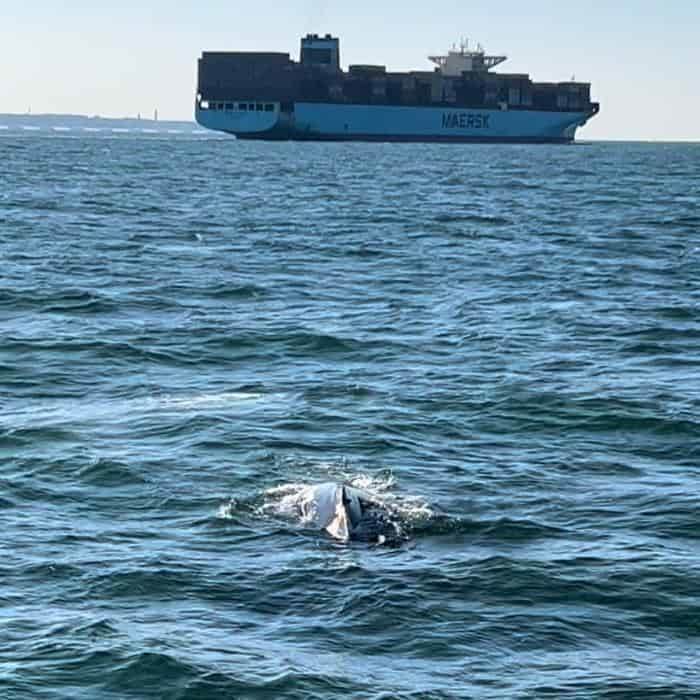
When is the Best Time to Go Whale Watching at Virginia Beach?
Whale sightings are guaranteed by Rudee Tours during the winter season of December-February in Virginia Beach when they are migrating in large numbers.
If you don’t see a whale during your boat trip during the prime months with Rudee Tours you can go on another whale-watching tour for free. (No refunds)
Whales can be seen, as early as Thanksgiving, until early March but the best months are still December-February.
Rudee Tours is one of the few tour operators in the Virginia Beach area with a “whale sighting guarantee” for their tours. This greatly improves your odds of a higher success rate of seeing a whale during your visit.
I recommend booking your tour toward the beginning of your visit to Virginia Beach. That way you have enough time to try again if the tour gets canceled due to weather or if you want to go again.

What Types of Whales Are in the Atlantic Ocean Near Virginia Beach’s Chesapeake Bay?
You find the following marine mammals and species of whales near Virginia Beach:
- Humpback whales
- Juvenile humpback whales
- Fin whales
- Minke whales
- Bottlenose dolphins
- Harbor porpoises
Rare sightings may also include the following endangered whales:
- North Atlantic Right whales (See drone footage)
- Blue Whale
Marine biologists monitor and collect data on whale migration patterns to better understand the changing conditions of the environment.

Our Whale-Watching Tour Experience on the Rudee Flipper
During our visit, the weather was COLD but sunny.
It was around 35 degrees during our tour but at least we had sunshine and the wind wasn’t too bad. Air temperatures are much cooler when you’re out on the water.

Toward the beginning of your boat tour, you can see Virginia Beach’s hotels stretched along the coast of Virginia Beach. The Virginia Beach shores stretch out 38 miles and there are 28 miles of public beach.

As we traveled the coastal waters I did see several harbor seals in the distance relaxing on a buoy and lots of sea birds diving into the cold water.
Be on the lookout for Northern Gannets, another observed species that can be found in the area.
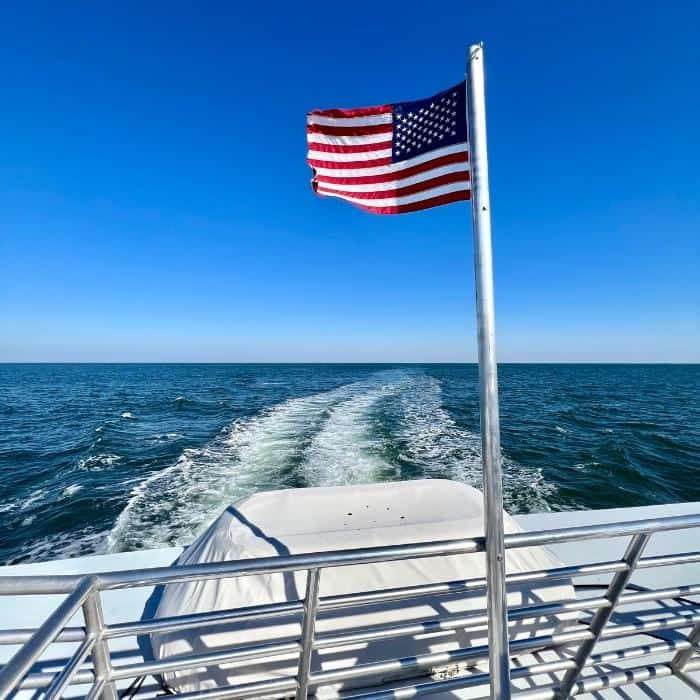
While you travel the Atlantic Coast, you can just relax and enjoy the scenic view as you anticipate seeing whales in their natural habitat.

Learn From Staff With Years of Whale Watching Experience
During our tour, one of the staff members walked around the boat providing a mini-education program with visuals and information on humpback whales.
We learned that a humpback whale has a small dorsal fin and long pectoral flippers.
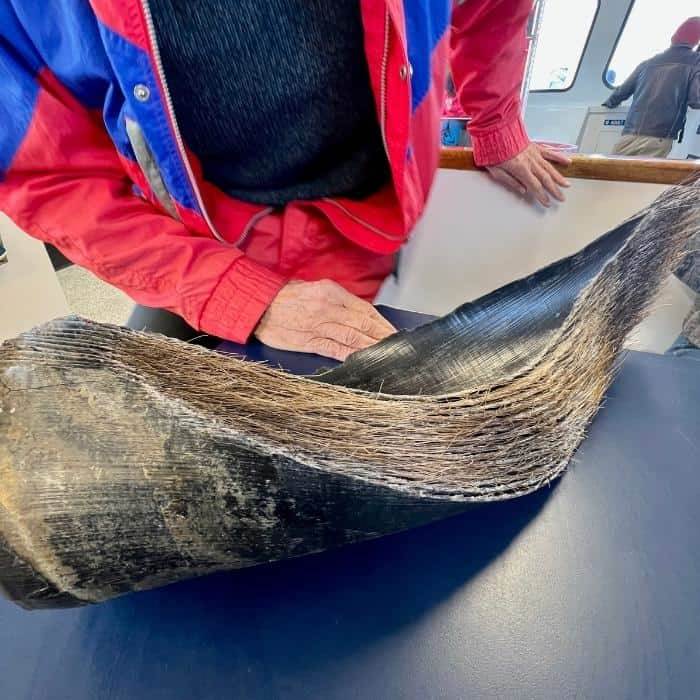
We also learned that humpback whales are a type of Baleen whales. Baleen whales don’t have teeth and use baleen filter feeders in their mouths.
The overlapping plates in their mouth allow them to take in large gulps of water and keep the food in their mouth while filtering the water back out of their mouths.

The plates in their mouth are made of keratin, the same hardened protein found in a human fingernail. We were also able to ask additional questions during our time together.
During your cruise, you’ll learn interesting facts about the local ecology and wild animals from experienced researchers and naturalists.
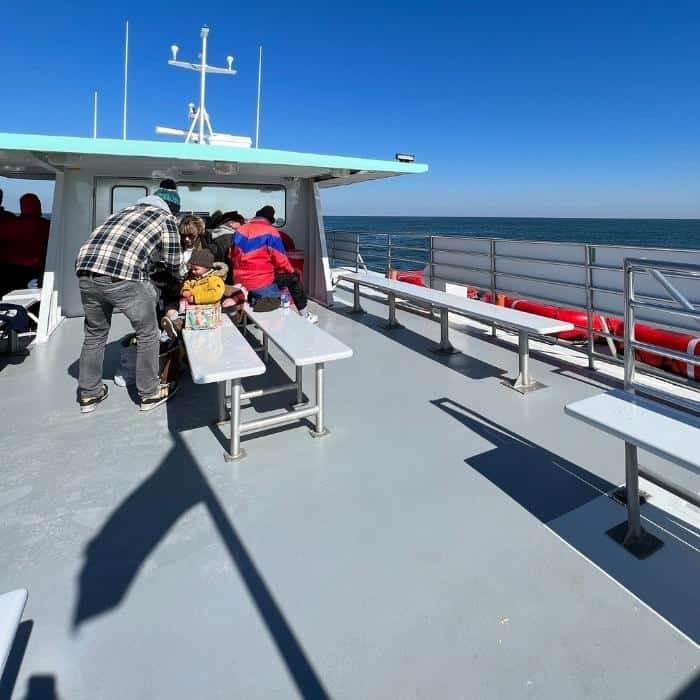
Seating Options on the Rudee Flipper
There are seating options on both the upper deck and lower deck. Once we started seeing whales I preferred the vantage point from the upper deck over the lower deck.
It was also easier to quickly change locations on the boat as the whales moved their positions in the water.

If you want to stay warm, the seating area toward the front of the climate-controlled cabin is one of the best places to sit.
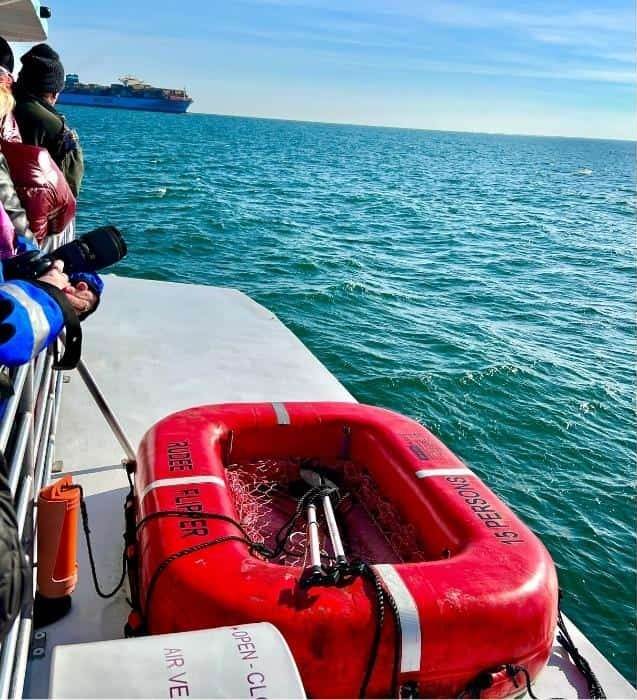
Be prepared to move quickly from one side of the boat to the other once the whales are spotted. I decided to video the whales with my cell phone instead of trying to take pictures.
I wanted to experience “living in the moment” and get “the shot.” I knew that I could screenshot an image from my video afterward.
It’s a good idea to have your cellphone or all your camera equipment charged ahead of time.
Check out the incredible photos by Kristin Rayfield from Rudee Tours and the other Whale Sense photo contest winners.
Where Do Humpback Whales Migrate To and From?
Humpback whales on the east coast migrate from the coasts of Canada and New England for warmer Atlantic Ocean waters as far south as the West Indies.
Many species of whales prefer the warmer waters during the breeding season.
Fortunately, humpback whales can be spotted near the mouth of the Chesapeake Bay as an annual stop because of the abundance of food for whales in the area.
In the summer months, humpback whales spend most of their time in the Arctic Ocean and near the chilly waters of New England.
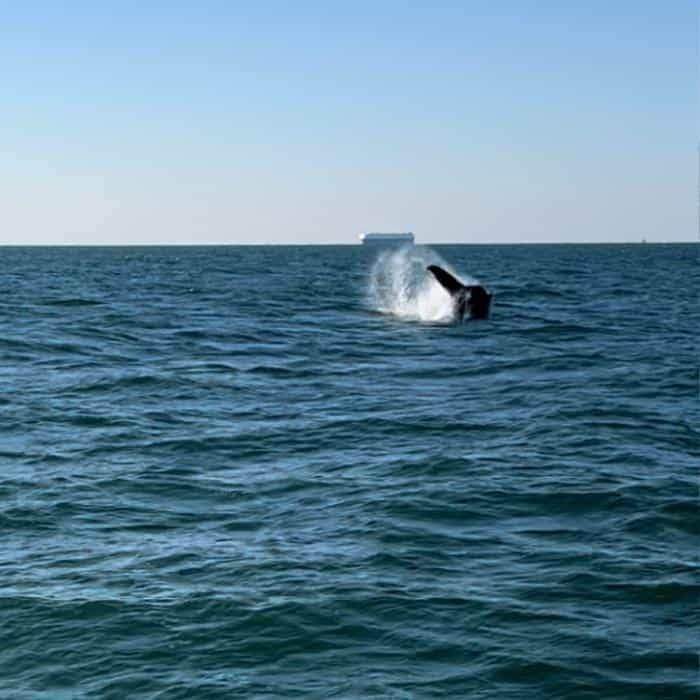
Did We See Whales During Our Whale Watching Tour?
YES!!! We saw 3 different humpback whales during our whale-watching tour.
During your whale-watching tour, you may see tail lobbing, flipper slapping, or one of the most unremarkable experiences to witness, a whale breaching out of the water.
No two whale-watching tours are the same. This footage of two acrobatic humpback whales was captured the day AFTER my whale-watching tour.
You can also check out this interview with Alexis Rabon from Rudee Tours.
Our 2-hour tour went a little over and was worth it because we saw more whales on the way back.
The whales typically surface 3 times within a relatively short amount of time before taking a deep dive. So if you miss seeing the whale the first time you should be able to see it the second time it surfaces.

What to Know Before You Go Virginia Beach Whale Watching
Check the weather before you go. Trips may be canceled if there are high winds which would make for a rough boat ride.
If it’s going to be really cold, I would recommend staying inside the heated cabin until whale sightings are announced by the staff.
Guests check in at the office before boarding 30 minutes before your departure.
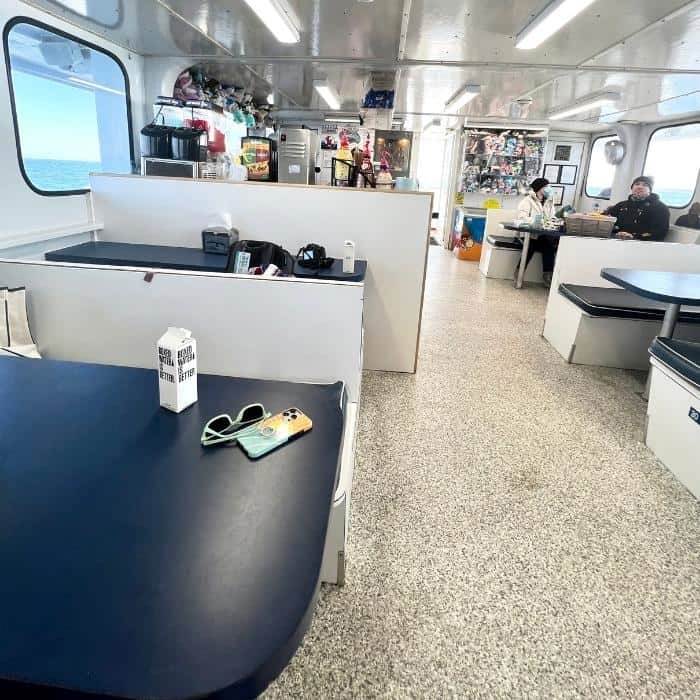
There’s an indoor cabin with seating, a snack bar with a full bar, two bathrooms, and a small gift shop if you want to purchase a souvenir.
The tour boats are ADA-compliant if you are traveling with a guest with special needs.
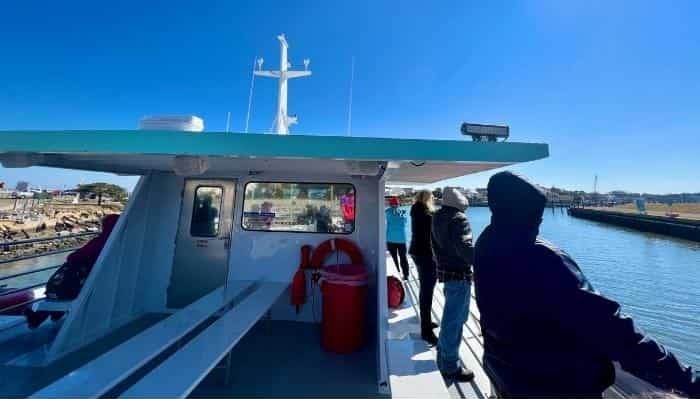
What Should You Wear For a Whale Watching Tour in the Winter?
You’ll want to dress in layers for a tour on a cold day.
- Polarized Sunglasses
- Touchscreen gloves or gloves with finger flaps (easier to take pictures and video on your phone)
- Hand Warmers
- Warm Hat
- Neck Warmer Winter Scarf
- Jacket with a hood
- Warm boots/Close-toed shoes
- Merino wool socks

Don’t Forget to Bring These Items on a Whale Watching Tour
- Camera with a good zoom lens (100-400)
- Binoculars
- Extra battery (Power Bank) external phone charger
- Motion sickness medicine or a nausea relief band if you typically experience nausea on boats. (The “seasick-o-meter” sign on the dock helps guests gauge how rough the waters are from a scale of 1-10.)

Additional Eco-Excursion Tours and Cruises From Rudee Tours
A whale-watching season pass is available if you want to experience unlimited trips during the season.
If you prefer more time on the water, consider Rudee’s Winter Wildlife Excursion. This 4-hour tour is for ages 4+ where guests will see humpback whales and harbor seals from January to March.
In May the Pelagic Wildlife Exploration tours resume that take guests 70 miles offshore on a 13-hour tour. Guests can see various species of whales, dolphins, sea turtles, and seabirds including brown pelicans.
Rudee Tours also offers a variety of fishing charters and tours.
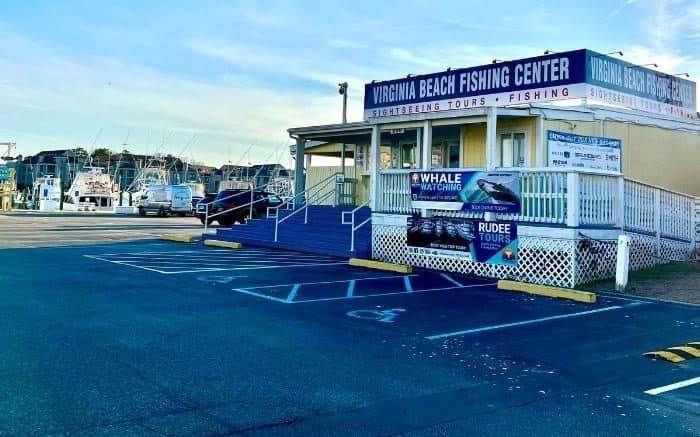
Where Do You Meet For the Rudee Tour?
200 Winston Salem Ave, Virginia Beach, VA
Tour guests depart from Rudee Inlet at the Virginia Beach Fishing Center a short drive from the Virginia Beach boardwalk. Tour guests enjoy free parking while on their cruise.
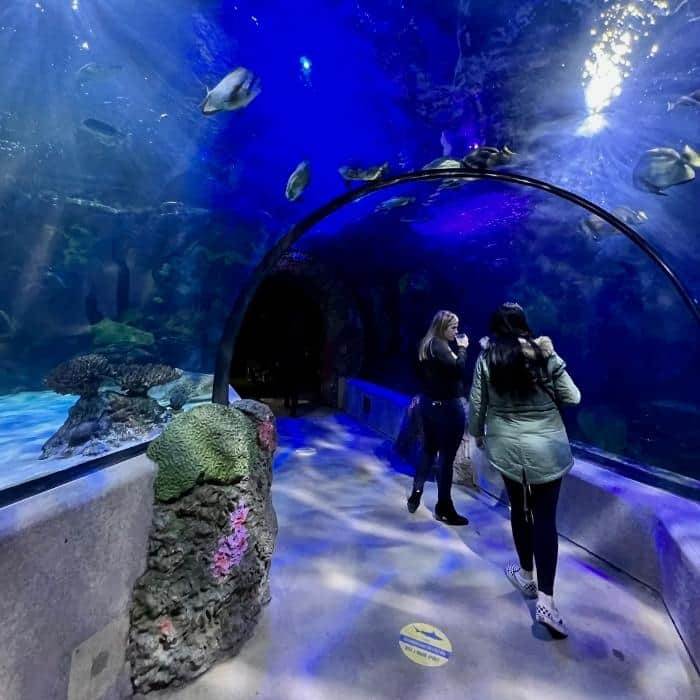
Learn More About Sea Life at the Virginia Aquarium & Marine Science Center
717 General Booth Blvd, Virginia Beach, VA
You can enhance your visit to the area with a visit to the Virginia Aquarium & Marine Science Center located on scenic Owls Creek.
The museum recommends allowing 1-2 hours for a self-guided tour of the interactive exhibits at the aquarium. Highlights include seeing a Komodo dragon, North American River otters, harbor seals, and sea turtles.
The Virginia Aquarium & Marine Science Center is also a part of several conservation efforts outside the aquarium walls.
Whale Watching tours also depart from the Virginia Aquarium and Marine Science Center dock on the Atlantic Explorer but whale sightings are not guaranteed.
If you visit during the warmer/ summer months, the dolphin-watching trips run from spring through fall at the aquarium.
If you want a smaller private boat experience consider a tour with First Landing Charters.

Is Whale Watching on Your Adventure List?
Need some more ideas while you’re in Virginia Beach?
Check out these fun things to do in Virginia Beach with young adults.
Looking for More Adventures Around Virginia Beach?
Check out the following tours in Virginia Beach below.


